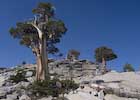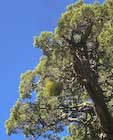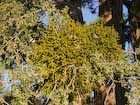Conservation Status

Juniperus grandis
Adams 2006
Common names
Sierra juniper (Peattie 1950).
Taxonomic notes
This taxon was regarded as synonymous with Juniperus occidentalis until Vasek (1966) described it as a distinct subspecies; following leaf essential oil and genetic analyses, Adams (2006) elevated it to species rank. That rank is now widely accepted on the basis of leaf essential oil, genetic, morphological, and interbreeding evidence; both J. occidentalis and J. grandis have been reported to hybridize with J. osteosperma in northwestern Nevada (Miller et al. 2005, Adams 1993). Current understanding is that J. grandis, J. occidentalis, and J. osteosperma are closely related but consistently distinct taxa, capable of hybridization but with little evidence of introgression, and showing consistent ecological differences. See also Adams and Kauffmann (2010a, 2010b) for more recent work on this species complex, which also finds infraspecific differentiation between Sierra Nevada and Transverse Ranges populations.
Synonymy:
- Juniperus occidentalis Hook. subsp. australis Vasek 1966;
- J. occidentalis Hook. var. australis (Vasek) Holmgren et Holmgren 1972.
The type was collected in 1961 by F.C. Vasek (Vasek 610929-38) along Poligue Canyon Road to Holcomb Valley in the San Bernardino Mountains.
Description
Dioecious (occasionally monoecious) evergreen trees 10-15(-30) m tall and 30-100(-250) cm dbh, usually single-stemmed. Branches thick, ascending or spreading, often curved or contorted, the foliage branches forming dense rounded tufts at the ends of the heavy main branches, forming a pyramidal crown in young trees, becoming rounded and irregular in old trees. Bark first smooth, pink-brown, then becoming grey and flaking; then fibrous, red-brown to brown, exfoliating in thin strips. Branchlets numerous, stout, 4-sided in cross section, (1.2-)1.5-2 mm thick, branching at 60° or less. Leaves dark green, abaxial glands oval, conspicuous, often with yellow or white exudate, margins denticulate (at 20×); whip leaves 3-6 mm, not glaucous adaxially; scale-like leaves in whorls of 4, 2-3 × 2 mm, ovoid-rhombic, acute or obtuse, not overlapping, appressed. Pollen cones numerous, terminal on short ultimate branchlets, subglobose to ovoid-oblong, 3-5 × 2-3 mm, yellow-green maturing yellow-brown; microsporophylls (10-)12-16(-18). Seed cones maturing in 2 years, terminal on ultimate branchlets, initially 2 mm diameter with 4-6 spreading bracts, growing in two seasons from purple-red to blue or purple with a glaucous bloom, subglobose, ca. 8.5 mm diameter, fleshy or pulpy, more or less resinous, eventually dry, falling soon after ripe. Seeds 1-2 per cone, ovoid or semi-ovoid, 5-6(-7) × 4-5 mm, with shallow grooves and resinous pits, yellowish-brown. Cotyledons 3-4, juvenile leaves only on seedlings (Adams 1993, Farjon 2005).
Distribution and Ecology
USA: California, at 1000-3000 m elevation on dry rocky slopes (Adams 1993).
Distribution of the primary serrate-leaf-margin Juniperus taxa of western North America; J. grandis shown in blue. Click on any marker for more information and a link to the source.
In the Sierra Nevada, it grows on shallow soils, often with Abies magnifica, Pinus albicaulis, Pinus contorta subsp. murrayana, Pinus jeffreyi, or Tsuga mertensiana (Sowder and Mowat 1965). At the southern extension of its range in San Bernardino County, it generally grows at a higher elevation than Juniperus californica and J. osteosperma (Munz and Keck 1959). This is the only documented area where J. occidentalis and Pinus monophylla grow together in a piñon-juniper woodland, although their distributions overlap geographically near the west edge of Nevada and from east-central to southern California (Griffin and Critchfield 1972, Horton 1960).
Remarkable Specimens
The "Bennett Juniper" is the largest known specimen of Juniperus. It has a diameter of 388 cm, height 26 m, crown spread 18 m, located in Stanislaus National Forest, CA (American Forests 1996). As of early 2023, it remains superlative. California's official "big tree" of J. occidentalis (UFEI 2023), which grows near the southern end of the zone where hybrids of the two species occur, also appears to be J. grandis, although it is marked as "Juniperus occidentalis" by an old Forest Service sign that predates the recognition of J. grandis as a distinct species.
The oldest known tree is the "Scofield Juniper", which has yielded a crossdated age of 2675 years (Miles and Worthington 1998, cited in RMTRR 2006). The "Bennett Juniper", mentioned above, has yielded a crossdated age of 1221 years and was estimated by the analyst, Peter Brown, to be about 2000-2300 years old in 2024, based on evidence from radiocarbon sampling (Brown 2024).
Ethnobotany
Little used. They are a popular subject for bonsai, and have proven useful in dendrochronological research. The most noted use to date has probably been a temperature reconstruction done by Graumlich (1991).
Observations
Readily seen in Yosemite National Park, for example in the Tuolumne Meadows area, and in the high country of Sequoia and Kings Canyon National Parks.
Remarks
"The top is almost always dead in old trees. Some are mere weathered stumps, decorated with a few leafy sprays, reminding one of the crumbling towers of some ancient castle" (Muir 1894).
This species is a host for the mistletoe Phoradendron juniperinum Engelm. ex A. Gray, shown in photos at right.
Citations
Adams, Robert P. 1993. Juniperus. Flora of North America Editorial Committee (eds.): Flora of North America North of Mexico, Vol. 2. Oxford University Press. This document is available online. Go to http://www.efloras.org, click on "Flora of North America," and search for "Juniperus."
Adams, R. P., S. Nguyen, J. A. Morris and A. E. Schwarzbach. 2006. Re-examination of the taxonomy of the one-seeded, serrate leaf Juniperus of southwestern United States and northern Mexico (Cupressaceae). Phytologia 88(3):299-310.
Adams, Robert P., and Michael E. Kauffmann. 2010a. Geographic variation in the leaf essential oils of Juniperus grandis and comparison with J. occidentalis and J. osteosperma. Phytologia 92(2):167-185.
Adams, Robert P., and Michael E. Kauffmann. 2010b. Geographic variation in nrDNA and cp DNA of Juniperus californica, J. grandis, J. occidentalis and J. osteosperma (Cupressaceae). Phytologia 92(2):266-276.
American Forests 1996. The 1996-1997 National Register of Big Trees. Washington, DC: American Forests.
Brown, Peter M. 2024. A revised estimated age for the Bennett juniper from tree-ring and radiocarbon dates. Madroño 71(3):122-126.
Graumlich, Lisa J. 1991. Subalpine tree growth, climate, and increasing CO2: An assessment of recent growth trends. Ecology 72(1): 1-11.
Holmgren, A. H. and N. H. Holmgren. 1972. Intermountain Flora 1: 239.
Hooker, William Jackson. 1838. Flora Boreali-Americana 2 (10): 166.
Horton, Jerome S. 1960. Vegetation types of the San Bernardino Mountains. Technical Paper 44. Berkeley, CA: USFS Pacific Southwest Forest and Range Experiment Station. 29 p.
Miles, D. H. and M. J. Worthington. 1998. Sonora Pass junipers from California USA: construction of a 3,500-year chronology. In V. Stravinskiene and R. Juknys, editors. Dendrochronology and Environmental Trends - Proceedings of the International Conference 17-21 June 1998, Kaunas, Lithuania. Vytautas Magnas University.
Miller, R. F., J. D. Bates, T. J. Svejcar, F. B. Pierson, and L. E. Eddleman. 2005. Biology, Ecology, and Management of Western Juniper (Juniperus occidentalis). Oregon State University Agricultural Experiment Station Technical Bulletin 152. 82pp. (Highly recommended. Can be found on the Web.)
Munz, Philip A. and David D. Keck. 1959. A California flora. Berkeley, CA: University of California Press. 1,681 p.
Sowder, James E. and Edwin L. Mowat. 1965. Western juniper (Juniperus occidentalis Hook.), p. 223-225 in H.A. Fowells (ed.), Silvics of forest trees of the United States. Agriculture Handbook 271. Washington, DC: U.S. Department of Agriculture.
UFEI. 2023. California Big Trees. https://californiabigtrees.calpoly.edu/bt-tree-detail/496, accessed 2023.08.06.
See also
Arno, Stephen F. and Jane Gyer. 1973. Discovering Sierra trees. Yosemite Natural History Association. 89pp.
Dealy, J. E. 1990. Western juniper, in Burns and Honkala (1990).
Lanner (1999).
Tresidder, Mary Curry. 1948. Sierra Juniper (accessed 2009.04.13), an online excerpt from the book Trees of Yosemite. Nice woodcut illustrations.
FEIS database.







